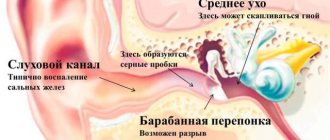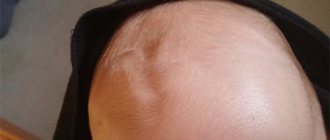A newborn baby is a very fragile creature. You need to treat him reverently and tenderly. Knowing this, many new mothers and fathers in the first days after the birth of their beloved child are often afraid of harming the baby with their careless actions. And the greatest concern among parents, as a rule, is the fontanel (or crown). After all, it is this soft part of the baby’s head that is somehow very scary to touch. It seems like one awkward movement and that’s it – at the very least, the child is guaranteed a brain injury. In addition, people say that a crown that is too small, or vice versa, a large soft crown, indicates some kind of anomaly in the development of the baby. Is this true or not? What crown size is considered normal? And when does a newborn’s fontanel close up? Doctors have clear and precise answers to these questions.
- 2 But the baby has more than one fontanel!
- 3 Functions
- 4 When should the soft crown heal?
- 5 Normal condition and possible deviations
- 6 Video “Everything about the fontanel in newborns” - Komarovsky
Where is the child's fontanel?
The fontanel is a soft space between the bones of the skull, filled with connective tissue, which ossifies during the growth and development of the child.
In addition to the large fontanel, there are 5 smaller ones, but they, as a rule, close during childbirth
Not many people know that in fact, a baby’s skull initially has 6 fontanelles , not just one. By the time of birth, all 5 (or 4, not including the back one), except for the large one, may be overgrown, or they may remain of insignificant size. Fontanas, like everything else in the human body, are not at all random - they play an important role.
During childbirth, thanks to the fontanelles, the baby's skull contracts and passes through the birth canal. After this, already in extrauterine life, the fontanelles, which are not overgrown, play the role of shock absorbers during impacts, preventing brain damage.
In addition, the fontanelles do not allow the bones of the skull to put pressure on the child’s rapidly growing brain , and at elevated temperatures they play the role of thermostats, preventing the brain from overheating.
The child’s brain is actively growing and the incompletely ossified skull prevents it from being compressed.
New mothers, without outside help, know where the notorious large fontanelle is located. It’s hard not to notice it on the baby’s head, because it occupies an area of 3 by 3 cm in the very center of the crown. A small posterior fontanel is located on the back of the head, but due to its small size, it often goes unnoticed.
The appearance of a large fontanel can tell a lot:
- a sunken fontanel in the first weeks of a baby’s life indicates that it is post-mature, and subsequently is an alarming signal of dehydration
- protrusion with pulsation indicates increased intracranial pressure. If this happens while crying, then this type of fontanel should be present, if at rest, consult a neurologist
- too slow closure may indicate the development of rickets or hydrocephalic syndrome
Be sure to tell us about your observations of the baby’s fontanel at the local pediatrician’s appointment, because the mother is with the child 24 hours a day and notices what escapes the doctor’s eyes.
A little about anatomy
The fontanel is a soft, non-ossified area of the cranial vault in a newborn child, located at the convergence of the bones. It is a remnant of the membranous formation that covers the brain from above at the initial stage of the formation of the fetal skull.
After the cartilaginous stage, these formations are replaced by bone tissue. Initially, bony points appear, similar to islands, in certain places. Then, gradually merging, these islands create bone plates and become the basis of the bones of the cranial vault.
By the time the child is born, these areas are preserved in the form of spacious spaces - fontanelles, or thin stripes - sutures. Due to their elasticity, they can protrude or sink (pulsate) under the influence of intracranial pressure. This pulsation is similar to the beating of water in a spring. Hence the name - by analogy.
Often parents are concerned about this very pulsation of the crown of their little one. They try not to even touch such a vulnerable spot on the child’s head.
But in reality, the skin covering the fontanel is very strong, and it is quite capable of protecting the baby’s head from touch, and sometimes even from serious injury.
In total, a child may have six fontanelles open at birth. Some of them close soon after the baby is born.
When should a child's fontanelle close up?
The timing of overgrowth of a large fontanel is quite individual. There are no strict criteria for exactly when the fontanel should ossify, but most pediatricians are inclined to think that this should happen between 6 and 18 months . As statistics show, most often the closure of the fontanel occurs from six months to a year , but there are cases when this happens earlier or later - at 3 months or up to two years.
Fontanas most often close between six months and a year, but can ossify much later
There is no need to worry if the fontanelle does not close during this most common period. Each child is individual, and if the neighbor’s baby’s fontanel has already closed, but yours has not, then this only speaks of his individual development.
Baby's skull bones during childbirth
In most natural births, the baby passes through the birth canal head first , which is the majority of his body. Nature designed the bones of the skull to be tiny that they are flexible and mobile and do not grow in the womb until the end.
They may even overlap where the fontanel is to make it easier for the head to pass through the birth canal. The brain is protected because it is located between two halves - the brain chamber and the cerebrospinal fluid . This system is cushioned, pressure, brain compression and overlap do not matter. When the head passes, then all other parts of the body easily go well directed.
Size of a child's fontanel by month
At every examination of the child, from the moment of his birth until complete closure, the pediatrician will measure the fontanel. This is necessary in order to have an idea of the rate of growth and development of the baby’s brain and improvement of the skull. There are certain standards that show what the size of the fontanel should be by month.
Sizes of a large fontanel by month
At birth, the size of a large fontanel is usually 3 by 3 cm, but may be slightly smaller or larger, which is not considered a deviation from the norm. Over the course of a month, the size of the fontanel may increase slightly , but this should not be alarmed. This is observed for the reason that during childbirth the child’s skull was strongly compressed, and after some time, due to the elasticity of the tissues, it returns to its previous shape.
Also, the enlargement of the fontanelle in the first month of a baby’s life.
After the first month, the size of the fontanel should gradually decrease until complete ossification occurs and the fontanel closes completely.
Functions
- At the time of birth, the largest part of the baby's body is its head (circumference). Therefore, when the baby passes through the birth canal, the head bears the heaviest load. And as a result of physiological compression, it becomes deformed. But it is thanks to the fontanelles that the baby’s head has elasticity and firmness. Therefore, compression and deformation do not harm either the skull or its contents.
- The fontanel is involved in the process of thermoregulation of the body. Since the thermoregulation mechanism of a newborn is still far from perfect, it tends to overheat more than the body of an adult. When temperatures rise, the fontanel promotes heat transfer, thereby regulating the temperature of the brain, meninges and the child’s entire body as a whole.
- The crown is endowed with the property of pulsating, for example, when intracranial pressure increases. That is why it often serves as an indicator of possible diseases.
- The fontanel also acts as a natural shock absorber and thereby protects the child’s brain from injury from impacts and falls.
Fontana in a child at 2 months
By the end of the second month of life, the fontanel may decrease slightly. For parents, these changes may go completely unnoticed, but the doctor will definitely pay attention to how the fontanel has changed. the fontanel of a two-month-old baby should be like - after all, it is important to take into account what it was like at birth.
On average, by two months the fontanel can become 22-25 mm . As a rule, closure of the fontanel should not occur so early, and if this happens, it is better to consult with a pediatrician, because the baby is still very small, his brain is actively developing and growing, and earlier closure of the fontanel can be extremely undesirable at this age.
If the fontanel closes by two months, then they talk about its early closure
Early overgrowth of the fontanelle (up to 3 months) is considered pathological only if head circumference dimensions atypical for this age are observed. If the head circumference corresponds to the norms and terms, then the child is considered healthy, and earlier closure of the fontanelle is a feature of the individual development of the skeletal system.
Reasons for early overgrowth of fontanel:
- excess calcium that enters the body
- underdevelopment of the brain
- Craniosynostosis is a specific disease that occurs against the background of endocrine diseases or rickets, which is characterized by early closure of the sutures of the skull and multiple associated symptoms (very rare)
- brain abnormalities (extremely rarely causes overgrowth of the fontanel)
talk about early overgrowth of the fontanel due to any disease. And only after a specific diagnosis can any measures be taken to stop the ossification of the fontanel.
Peculiarities
The fontanelle is formed at the junction of the child’s cranial bones, connected by soft membranous tissue. It is dense enough to protect the brain from external influences: you can not be afraid to wash, comb and stroke your baby’s head.
During intrauterine development, 6 fontanelles are formed:
- Two pairs on the sides (in front of the ears and behind them) - quite narrow, more like seams. They drag on at the time of birth or immediately after it and are invisible to parents:
- Small in the occipital region (approximately 5 mm in diameter) - in most cases closes during intrauterine development, more often observed in premature babies. Its overgrowth with bone tissue lasts from several days to two months;
- The large one, located on the crown, is tightened last. Its dimensions vary between 22-35 mm.
A baby may be born with an abnormally large fontanel as a result of prematurity, hydrocephalus (accumulation of excess fluid in the ventricles of the brain), or disorders in the development of the skeletal system. Reduced size of the parietal and complete closure of the remaining fontanels is possible when the disproportion of the skull and brain is too small compared to other parts of the body. Such cases require medical supervision and additional research to determine the causes. The rate of overgrowth of the fontanel in children with congenital pathologies may differ compared to children without abnormalities.
Fontana in a child at 3 months
Only in 1% of children does the large fontanelle close up at 3 months , and in average babies by this age it becomes 23-24 mm . If your baby belongs to this small percentage of children who have by 3 months , then you should not raise the alarm and drag your child to hospitals.
In 1% of children, the fontanel closes at three months
If the large fontanel has closed , but the child is developing according to schedule, you do not observe any pathologies or oddities in behavior, and the baby’s head circumference corresponds to his age, then such closure of the fontanel is considered a physiological phenomenon.
Mild dehydration
The main causes of mild dehydration, in which the crown of the head sinks, are insufficient fluid intake into the body and overheating. The table will help you understand how much fluid your child needs:
For example, a baby is 4 months old and weighs 6 kg. This means he needs 900 ml of fluid per day. From this amount you need to subtract the volume of breast milk or formula that the baby receives. As a result, the amount of drink that needs to be given additionally will come out.
It is worth noting that with natural feeding, carried out on demand, the baby, as a rule, does not require additional liquid. With artificial nutrition, drinking is mandatory. The baby should be offered boiled or special baby water.
To prevent dehydration, your child should drink the appropriate amount of fluid for their age.
You can avoid the appearance of a sunken crown due to overheating by observing certain air parameters in the room and dressing the child correctly. Famous pediatrician E.O. Komarovsky advises adhering to the following indicators:
- air temperature – 18-22°C;
- relative humidity – 60-70% (this can be achieved using a household humidifier);
- a minimum number of items that accumulate dust - upholstered furniture, toys, carpets;
- regular wet cleaning;
- frequent through ventilation.
In addition, it is important to dress your child “for the weather.” Due to imperfect thermoregulation, too much wrapping quickly leads to overheating, as a result of which the body loses moisture and the membrane collapses. At a temperature of 20-22°, a cap is not needed, since it covers the fontanelle, through which the body cools. It is important to avoid keeping your baby in direct sunlight.
Fontana in a child at 4 months
From 3 to 4 months, the baby's fontanelle continues to close and its size is about 2 cm . Complete closure of the fontanel at this age is as rare as in the previous month, but isolated cases do occur. In general, complete ossification of the skull is uncharacteristic for a 4-month-old child.
Parents should not worry - if the fontanel overgrows at the wrong time , the pediatrician will definitely tell you about it at the next appointment. If necessary, the baby will be prescribed vitamin D or it will be recommended to increase the calcium content in the diet of the nursing mother.
Open fontanel with rickets
Vitamin D in large quantities is necessary for building the skeleton. It forms bone tissue and combines with calcium and magnesium. The child receives it in large quantities with mother's milk and formula. It is produced by the body under the influence of sunlight.
With rare walks on the street, poor diet or diseases of the digestive tract, vitamin D is not produced or absorbed from foods. The problem often arises when living in the northern regions, artificial nutrition, or an incorrectly selected mixture. With a long-term decrease in the concentration of a beneficial microelement, rickets can develop and phosphorus ceases to be absorbed.
The disease changes the structure of the bone tissue of the child's skeleton and skull. It occurs between 3 months and 3 years of age. The posterior and parietal fontanel does not close for a long time; the growth and development of the chest may be impaired. The consequence of the pathology is:
- weakened immune system;
- frequent colds;
- change in body proportions;
- anemia;
- dilation of veins in the abdominal cavity;
- dental diseases;
- rachiocampsis.
If the fontanel is not completely overgrown at 2 years of age, the child experiences sweating, poor sleep, and growth retardation, the doctor may prescribe a number of diagnostic procedures.
Fontana in a child at 5 months
From 5 months, the size of the large fontanel becomes about 17 mm . Most likely, over the next two to three months it will remain unchanged, but quite often, by 6-7 months the fontanel closes completely. The closure of the fontanel in subsequent months is not considered a pathology - this is a completely normal phenomenon.
According to average indicators, the fontanel has the following approximate sizes for up to a year:
- 8-9 months - 1.4-1.5 cm
- 9-10 months - 1.2-1.4 cm
- 10-11 months - 0.9-1.2 cm
- 11 months - year - 0.5-0.8 cm
If the head circumference corresponds to the timing, then the closure of the fontanel is considered physiological
As a rule, by the age of one year the baby’s fontanelle closes, and in many cases this happens earlier.
Probable deviations
We can talk about slow healing if by the age of 1.5 years the crown of the newborn is still not closed, and its size is 10-12 mm. At the same time, there are other alarming symptoms. It is incompetent to judge a disease by just one sign. The probable causes associated with various diseases and accompanied by concomitant pathologies are the following:
- Rickets is a long period of healing of the soft area against the background of disturbed sleep, anxiety, increased sweating of the scalp and a gradual change in the shape of the skull. The consequences of rickets are improper formation of the limbs, malocclusion, thickening on the ribs, sunken chest, deformation of the pelvic bones. If you suspect a disease, you must undergo a comprehensive examination by a neurologist.
- Hydrocephalus is sluggish healing accompanied by excess fluid accumulation in the brain. The consequences are very sad: delayed speech development, lethargy, problems expressing emotions;
- Dwarfism is a pathology of bone tissue, expressed in growth retardation, due to genetic inheritance.
External symptoms of rickets
According to Dr. Komarovsky, early closure (up to 3 months) or non-closure after 1.5 years is a reason to visit a neurologist and be examined to identify possible pathologies. According to statistics, by the age of one year the crown is overgrown in 25% of babies, by the age of 2 – in 95%.
Deviations from the norm in size and timing are not a reason to suspect serious illness in a child based solely on this factor. When making a diagnosis, it is necessary to collect as much information as possible regarding the development, well-being and growth of the baby. Parents need to monitor and note changes in his condition, and if they have questions or suspicions, consult a doctor.
Fontana in a premature baby
In premature babies, large fontanelles are observed at birth and, in addition to the anterior and posterior ones, there are also lateral fontanelles . Since premature babies are born earlier than expected, their development differs in many respects from the development of their peers and the overgrowth of fontanelles also occurs differently.
Closing of the fontanelle in premature babies occurs somewhat later than is considered normal, but this is not a cause for concern . Even if a child’s development is significantly behind his peers, his rate of development will return to normal by the age of three and will be equal to his peers.
The fontanel in premature babies closes later than in peers
As a rule, the large fontanel in premature babies closes at one and a half to two years . In rare cases, ossification occurs later - at 2.5 years.
Premature babies are under special supervision by pediatricians, and at the slightest suspicion of any pathology, the doctor will prescribe an appropriate examination to exclude the possible development of pathology. However, if any changes in your child’s fontanel bother you, be sure to consult a specialist.
Recession and protrusion of the fontanel
The fontanelle in an infant protrudes slightly when there is increased intracranial pressure or other neurological disorders. A bulging fontanel is not the only symptom indicating health problems. If you find that the membrane on your head is slightly swollen, do not panic, but rather consult a doctor immediately.
A sunken fontanel is usually a typical sign of dehydration in a baby. This happens with vomiting and prolonged diarrhea in a small child. In this situation, the newborn needs to be provided with plenty of fluids. It is necessary to contact a pediatrician to find out the reasons that led to dehydration and, as a result, the retraction of the fontanel.
Why does a child’s fontanel not heal well?
As already mentioned, ossification of the skull and retraction of the large fontanelle occurs differently in each child. how quickly the fontanel heals :
- full-term - if a child was born prematurely, he will lag behind his peers in development and the closure of the fontanel will occur much later than in full-term children
- nutrition - in children who are breastfed, the fontanel ossifies earlier than in artificially fed children. This is due to the fact that mother's milk contains a sufficient amount of calcium necessary for the formation and strengthening of the skeleton. Taking vitamin D, which helps calcium to be absorbed, also plays an important role in closing the fontanelle.
If the fontanel closes slowly, the doctor may prescribe vitamin D
- intensity of development - if the child grows slowly, then the fontanelle will overgrow at that pace
- heredity
- the presence of endocrine, neurological, genetic diseases
If the deadline for the fontanelle to heal has passed
Since the timing of overgrowth is largely determined by genetic inheritance, it is possible that late closure is a characteristic feature of the family on the father's or mother's side. However, the question of when exactly the crown of a newborn becomes overgrown, and why it takes so long, is very worrying for parents. The excitement is especially strong if children are compared with the children of acquaintances and friends close in age. In fact, the size and timing of overgrowth in children are individual, just like height, weight and eye color.
What to do if a child’s fontanel closes early?
Recently, cases of early fontanelle closure have become more frequent in pediatric practice. Pediatricians attribute this primarily to the fact that during pregnancy, expectant mothers of babies took complex vitamin preparations. As a result, an excess of calcium is observed in the child’s body, which leads to early closure of the fontanel.
If ossification occurs too early, then many experts talk about multiple negative consequences, because the rapidly growing brain slows down its development, compressed by the skull. In fact, no scientific research has been conducted on this matter and it is impossible to say that it is really dangerous to close the fontanel earlier.
A common cause of early closure of the fontanel is metabolic disorders
Therefore, if your pediatrician, after measuring the head circumference and other parameters, does not see any deviations from the norm in the child , then no action on your part is required to prevent the closure of the fontanel.
If the doctor considers that the rapid closure of the fontanel is due to metabolic disorders , namely due to excess calcium, then he will recommend reducing the consumption of foods containing calcium and vitamin D. You should not limit the child in such important substances on your own.
The fontanel plays a big role both during the birth of a child and after his birth. This delicate area of the child’s body requires special control and reverent attitude, because it can say a lot about the child’s condition and his development. If you are concerned about the appearance of the fontanelle or its closure, then you should definitely consult a pediatrician.
Fontana care
No special or special care is required for this delicate part of the head. You can touch it with your hands. The main thing is not to put pressure on this area. When combing your hair, do not press with the brush, act carefully. If yellow or brown crusts appear on the fontanel, do not immediately clean them off with nails or other sharp objects. It is enough to apply baby oil to your head; any vegetable oil will also do. After 30 minutes, comb out using a baby comb with rounded plastic teeth. It is completely safe to cut a child whose fontanel has not yet closed. Nothing will happen to him.
The normal state of an unovergrown fontanel is that its level corresponds to the bones of the skull. At the same time, when screaming or crying heavily, it may stick out a little. A slight pulsation is also allowed, which is due to the close passage of the cerebral artery. This may look a little scary, but is normal. This is where the name of this part of the skull comes from. In other countries it is also called a “fountain”.
If, in a calm state, the child’s fontanel sinks or bulges out, it is necessary to consult a neurologist. This may be a sign of increased intracranial pressure. Retraction of the fontanel may be due to severe dehydration after vomiting or diarrhea. This condition is critical and requires urgent action: immediately seek emergency help and quickly restore the child’s fluid balance. It is necessary to desolder by any possible means, optimally for oral hydration.
Pediatricians advise placing the baby alternately on one side and then on the other. This is necessary for uniform formation of the skull and to prevent “caking” of delicate areas. If the child is constantly on one side, the load on the crown will be uneven and can lead to internal pathology.
Protruding posterior fontanelle











